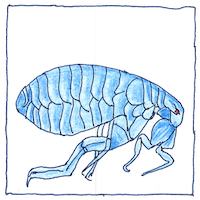Robert Hooke, Antonie van Leeuwenhock
biology

|
Microorganisms
Robert Hooke described a fly’s eye, discovered that plants have cells, and drew the hairs on the back of a flea. Antonie van Leeuwenhock described bacteria, blood cells flowing through capillaries, spermatozoa, and insects including the parasites of the flea. Leeuwenhock was the first to report the existence of single-celled organisms. This strained the credibility of members of the Royal Society of London so they sent a delegation to Delft to see whether Leeuwenhock was a madman or a genius. It turned out that on good testimony Leeuwenhock was sane, and that Hooke was able to verify Leeuwenhock’s observations.
Lenses
Leeuwenhock made his own tiny spherical lenses capable of magnification between 275 to 500 times by melting the tip of a thin thread of glass so that it formed a sphere. He set this sphere in a simple tool that held the sample to the light and let him adjust its position in three dimensions. Robert Hooke’s first microscopes descended from the compound lens telescope, but eventually he learned how to make tiny perfect lenses the way Leeuwenhock did.
Sense of scale
The bulk of living things on Earth are smaller than our eyes, unaided, can see, and so it takes naïveté or a form of intellect to accept, in the scale of things, our true insignificance.



Hooke’s Micrographia described not only very small things, but also the Pleiades and the craters of the moon. Without instruments, the exceedingly small and the exceedingly distant are impossible for us to see.
See also in The book of science:
Readings in wikipedia:
Other readings: